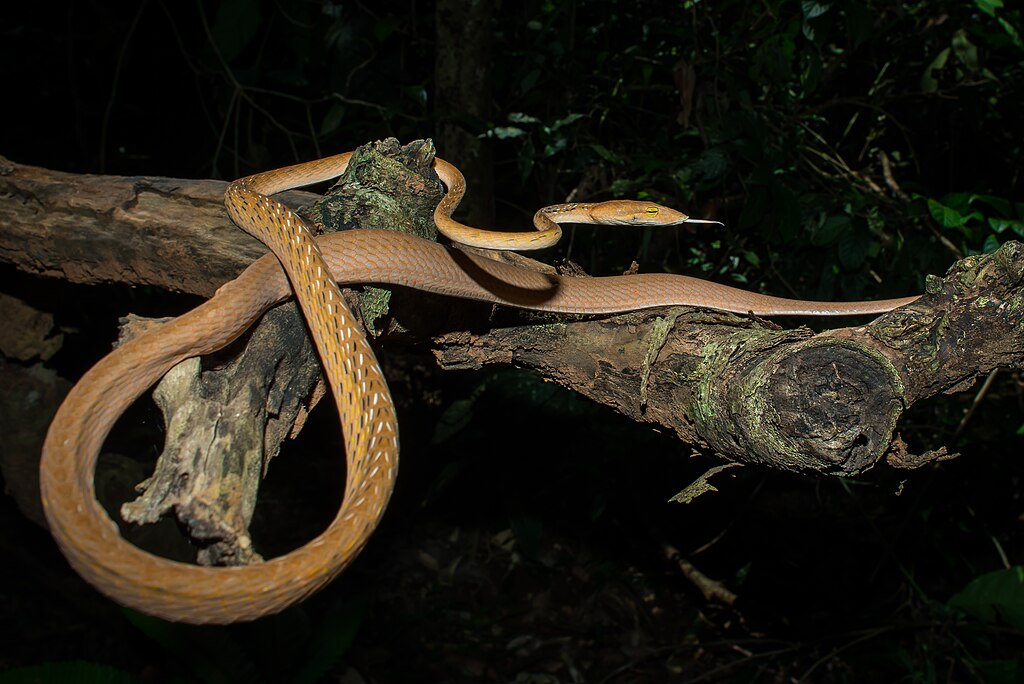In the dense forests of Southeast Asia, an extraordinary example of nature’s ingenuity quietly hunts among the foliage. The vine snake, a master of disguise, has evolved one of the most remarkable mimicry strategies in the animal kingdom—it perfectly replicates the swaying motion of flower stems in the breeze. This seemingly simple adaptation allows these slender predators to remain virtually invisible to both prey and potential threats, blending seamlessly into their verdant surroundings. The vine snake’s mimicry goes beyond mere physical resemblance; it’s a sophisticated behavioral adaptation that demonstrates the incredible evolutionary arms race between predator and prey. Their patient, rhythmic movements represent one of nature’s most elegant hunting strategies, turning these reptiles into living extensions of the plants they inhabit.
The Anatomical Design of Vine Snakes
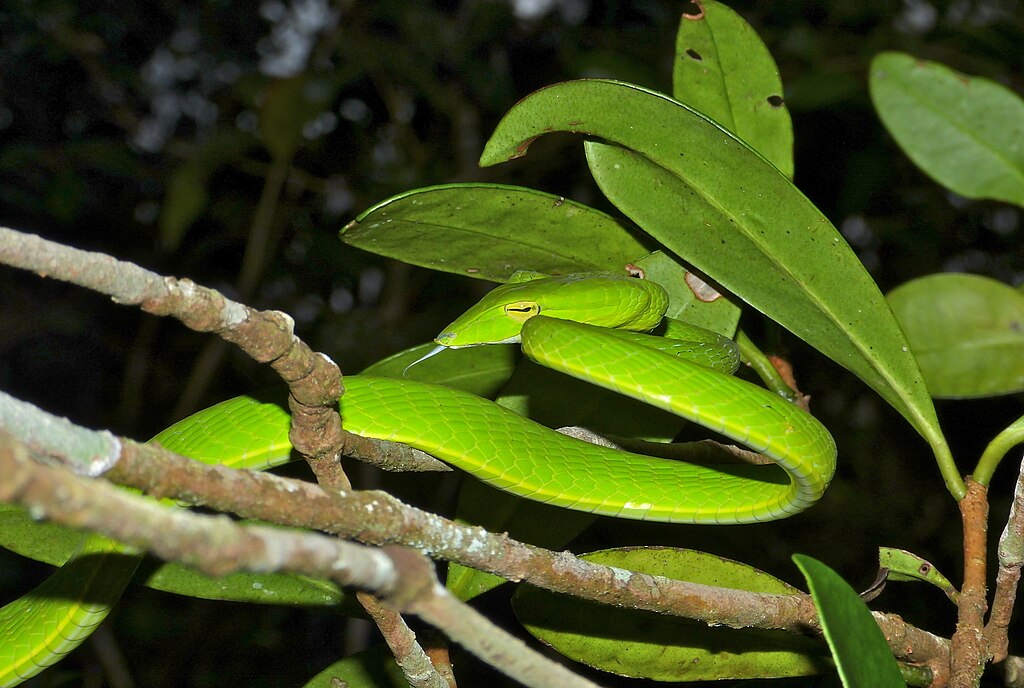
Vine snakes (primarily from the genera Ahaetulla and Oxybelis) possess uniquely adapted bodies that support their remarkable mimicry. Their extremely slender bodies, often less than a finger’s width, create the perfect silhouette to match thin plant stems and vines. Most species feature elongated heads that taper to a point, further enhancing the impression of a plant stem or twig. Their coloration—typically bright green, though some species display brown or grayish hues—provides excellent camouflage among the leaves and stems of their forest habitats. Perhaps most distinctive is their exceptionally long bodies relative to their diameter, with some individuals reaching lengths of up to 6 feet while maintaining their pencil-thin profile throughout.
The Sophisticated Swaying Behavior
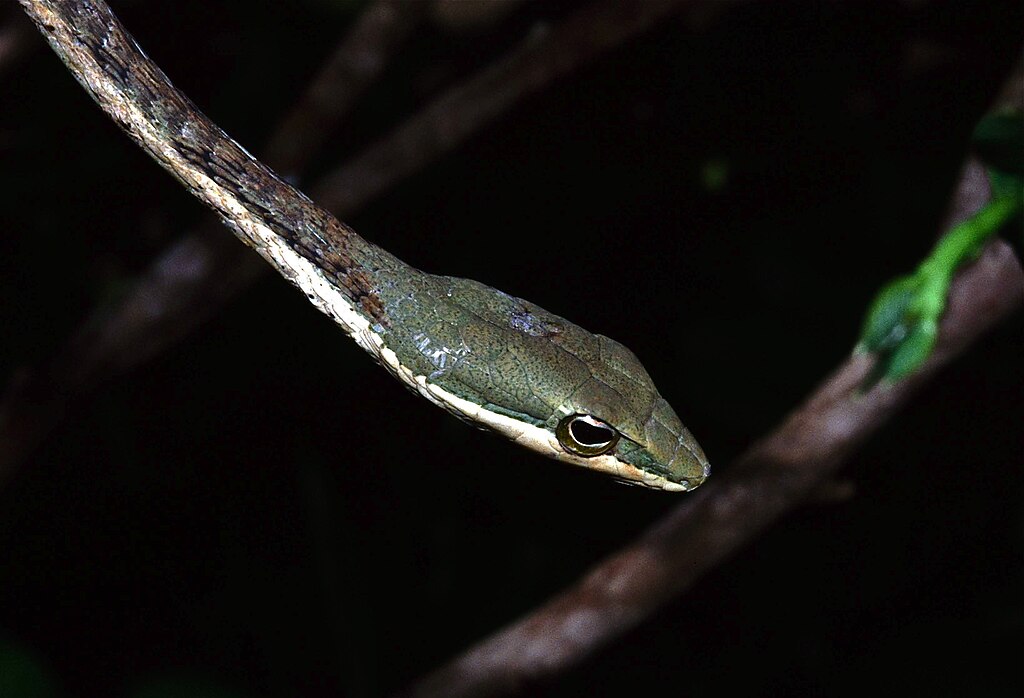
What truly sets vine snakes apart is their mesmerizing swaying behavior that perfectly mimics plant movements. When hunting or feeling threatened, these serpents will position their bodies in a distinctive S-shape and begin a gentle, rhythmic swaying that is virtually indistinguishable from the motion of vegetation in a light breeze. This behavior isn’t random or instinctive; vine snakes synchronize their movements with surrounding vegetation, creating the perfect illusion. The snake can maintain this swaying for extended periods, showing remarkable patience as they waits for potential prey to come within striking distance. Researchers have observed that the snakes can adjust both the speed and amplitude of their swaying based on environmental conditions, demonstrating a sophisticated awareness of their surroundings.
Evolutionary Development of the Mimicry

The vine snake’s remarkable mimicry capabilities represent millions of years of evolutionary refinement. Scientists believe this specialized behavior developed as a dual-purpose adaptation that serves both defensive and predatory functions. Initially, the ability to blend in with vegetation likely evolved as a defense mechanism against larger predators like birds of prey and mammals. Over generations, individuals with more convincing swaying movements would have had higher survival rates, gradually refining the behavior through natural selection. As this mimicry became more sophisticated, vine snakes gained a secondary advantage—the ability to ambush prey more effectively, leading to better hunting success. This dual benefit created strong evolutionary pressure to perfect the mimicry, resulting in the remarkably sophisticated behavior we observe today.
Hunting Strategy of the Floral Mimic

The vine snake’s hunting strategy represents a masterclass in patience and deception. After identifying a suitable hunting perch among vegetation, the snake assumes its swaying position and may remain motionless for hours, waiting for unsuspecting prey to approach. When a potential meal—typically a lizard, frog, or small bird—ventures too close, the snake freezes momentarily before executing a lightning-fast strike with remarkable precision. Most vine snake species possess mild venom delivered through enlarged rear fangs, which helps immobilize prey quickly after the initial strike. Unlike ambush predators that rely on bursts of speed, vine snakes exemplify the effectiveness of absolute stillness punctuated by precisely timed movement. Their success rate is remarkably high, with studies suggesting they successfully capture prey in over 80% of strike attempts.
Species Diversity and Distribution

The extraordinary flower stem mimicry behavior isn’t limited to a single species but appears across multiple vine snake species spanning different continents. The Asian vine snakes (Ahaetulla species) are perhaps the most well-known practitioners, with the common green vine snake (Ahaetulla nasuta) being particularly adept at this behavior throughout its range in South and Southeast Asia. In the Americas, the similar but distantly related New World vine snakes (Oxybelis species) have independently evolved nearly identical mimicry behaviors, a fascinating example of convergent evolution. Vine snakes can be found in tropical and subtropical forests from Central America through South America, across parts of Africa, and throughout southern and southeastern Asia. Each species has developed slight variations in its mimicry techniques based on its specific habitats and prey.
Visual Adaptations that Enhance the Disguise
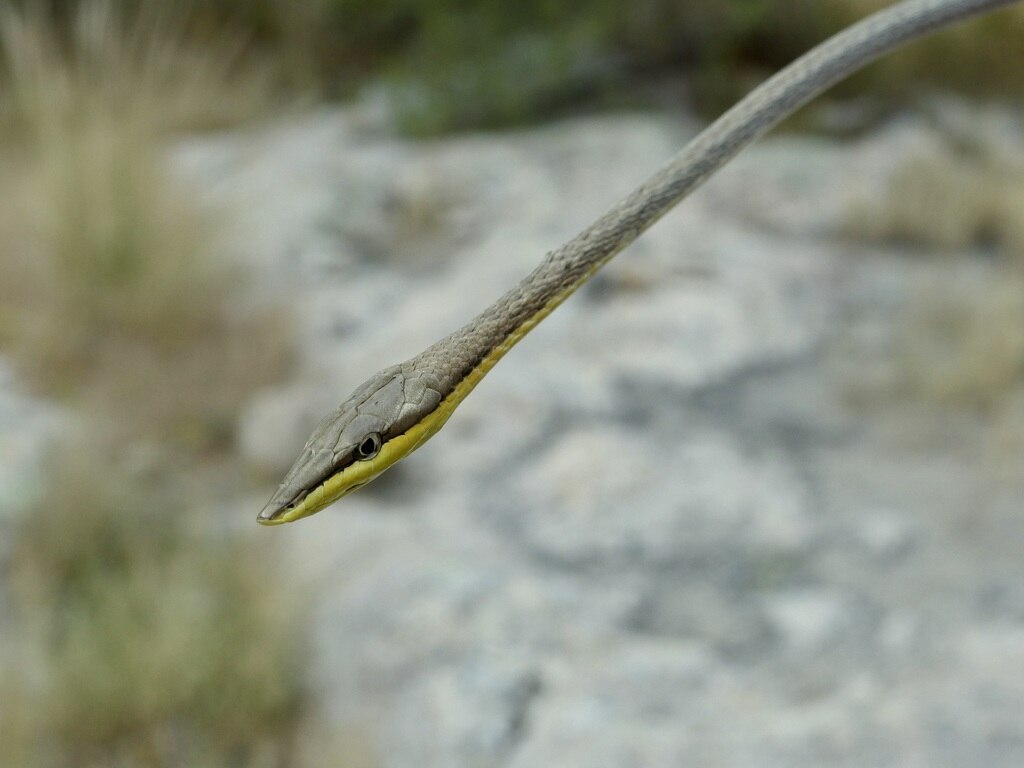
Vine snakes possess specialized visual adaptations that complement their remarkable behavioral mimicry. Most notable are their horizontal, keyhole-shaped pupils, which provide exceptional depth perception and peripheral vision—critical abilities for a predator that relies on precision strikes. Many species feature distinctive head shapes with pointed snouts and sometimes even leaf-like projections that further enhance their plant-like appearance. The scales on vine snakes tend to be keeled (ridged) in patterns that mimic the venation of leaves when viewed up close. Some species even possess subtle patterns that resemble leaf damage or discoloration, adding another layer to their disguise. These visual adaptations work in concert with their swaying behavior to create one of the most comprehensive mimicry systems known in the animal kingdom.
Neurological Basis for the Mimicking Movement

The neurological mechanisms that allow vine snakes to so perfectly replicate plant movements represent a fascinating area of ongoing research. Studies suggest these snakes possess highly specialized neural circuits that coordinate their unique swaying behaviors. Unlike many reptilian movements that rely primarily on reflexive responses, the vine snake’s mimicry appears to involve higher brain centers capable of processing visual information about surrounding vegetation motion. Researchers have identified specialized muscle control systems that allow for the precise, sustained swaying movements without causing fatigue. Particularly interesting is the snake’s ability to maintain these movements while simultaneously remaining alert to potential prey or threats, suggesting remarkable multitasking capabilities in their relatively simple nervous systems. Recent neurological studies using advanced imaging have begun mapping the specific brain regions activated during these mimicry behaviors.
Predators and Threats

Despite their impressive camouflage abilities, vine snakes face numerous threats in their natural habitats. Birds of prey with keen eyesight, particularly eagles and hawks, represent their primary natural predators, capable of spotting the subtle differences between the snake and actual vegetation. Larger snakes and some mammals will also prey on vine snakes if given the opportunity. Unfortunately, habitat destruction poses an increasingly serious threat to many vine snake populations, as their specialized lifestyle makes them particularly vulnerable to deforestation and fragmentation of tropical forests. Additionally, their slender bodies and delicate structures make them vulnerable to injury, with relatively high mortality rates even from minor wounds. Some species have become targets in the exotic pet trade, further pressuring wild populations despite the difficulty in maintaining these specialized hunters in captivity.
Similar Mimicry in Other Snake Species

While vine snakes represent perhaps the most sophisticated practitioners of plant mimicry in the serpent world, several other snake species employ similar strategies. The Asian vine snake’s relative, the Long-nosed Whip Snake (Ahaetulla mycterizans), combines its stem-swaying behavior with a remarkable nose extension that resembles a twig or bud. In North America, the Rough Green Snake (Opheodrys aestivus) exhibits more basic forms of plant mimicry, lacking the sophisticated swaying but utilizing its bright green coloration and slender body for camouflage. The African Twig Snake (Thelotornis kirtlandii) employs a different approach, remaining rigidly straight to resemble a dead branch rather than swaying like living vegetation. These varied approaches to plant mimicry across different snake lineages demonstrate how powerful this evolutionary strategy has been for snakes occupying arboreal niches worldwide.
Observing Vine Snakes in the Wild
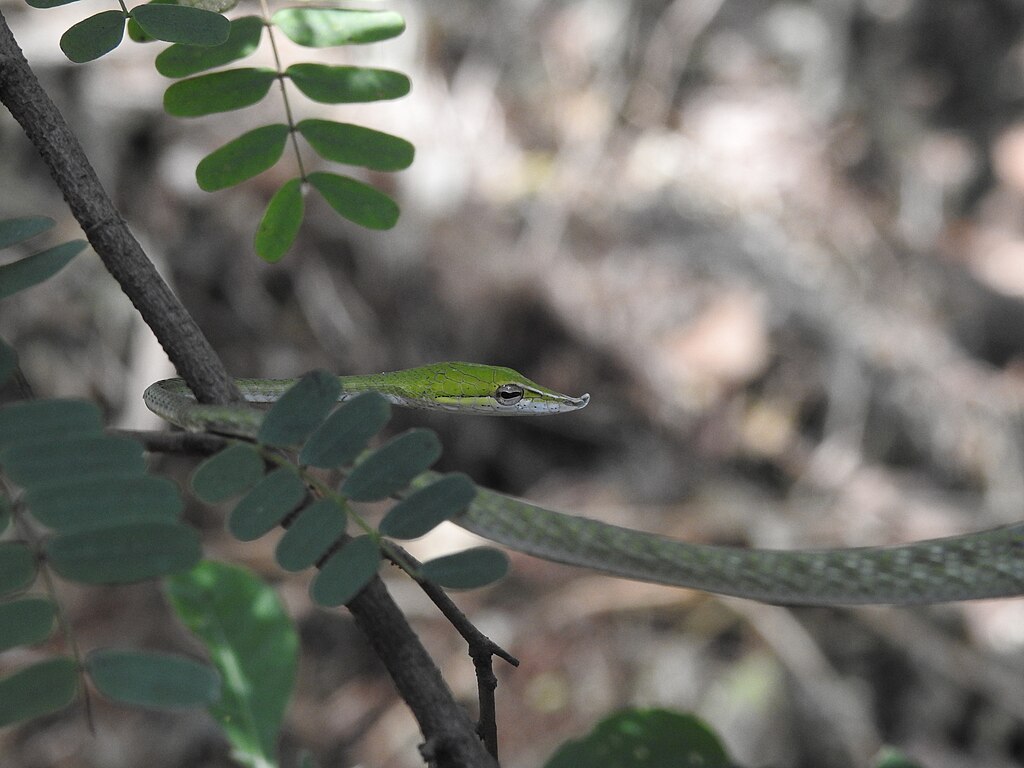
Spotting a vine snake in its natural habitat presents a significant challenge even for experienced wildlife observers. Their camouflage is so effective that many researchers rely on systematic search methods rather than opportunistic sightings. The best time to search for these elusive reptiles is during early morning or late afternoon when they’re most active but still exhibiting their swaying behavior. Experienced guides in places like India’s Western Ghats or Costa Rica’s rainforests often know specific locations where vine snakes regularly hunt. Binoculars are essential tools, allowing observers to scan vegetation carefully from a distance without disturbing the snake’s natural behavior. Wildlife photographers seeking to capture these masters of disguise often spend days or even weeks in the field, requiring extraordinary patience that mirrors the snake’s hunting strategy.
Conservation Status and Efforts
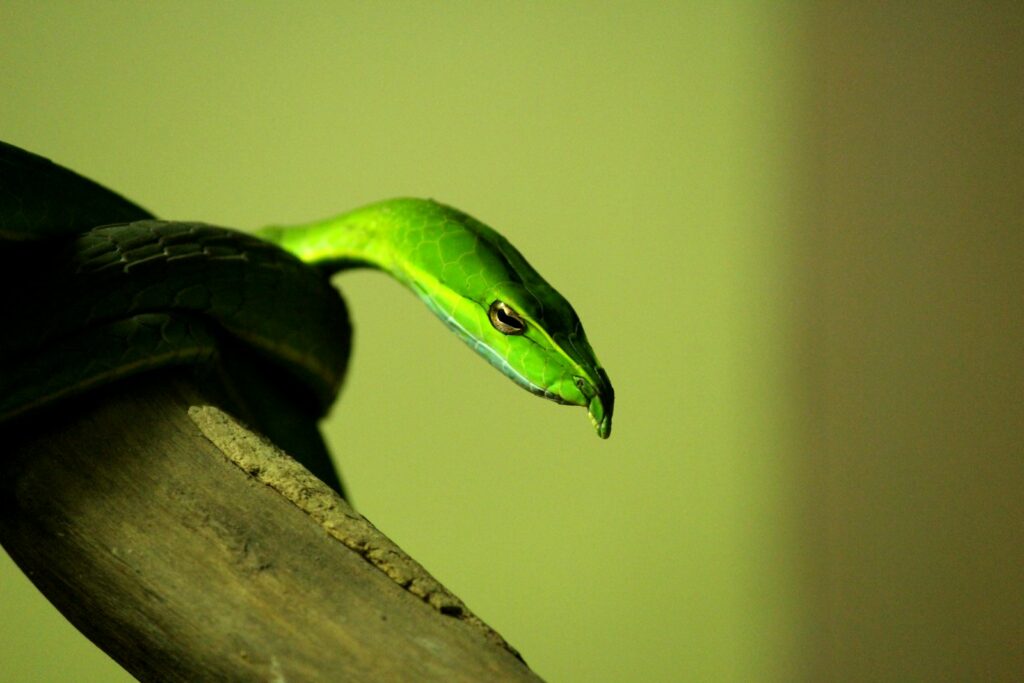
The conservation status of vine snakes varies considerably across different species and regions. While some species remain relatively common throughout their range, others face significant population declines due to habitat loss and fragmentation. The IUCN Red List currently lists several vine snake species as Near Threatened or Vulnerable, with population trends generally decreasing across most ranges. Conservation efforts specifically targeting vine snakes remain limited, though they benefit from broader tropical forest conservation initiatives in regions like Southeast Asia and Central America. Some nature reserves have developed specific monitoring programs to track vine snake populations as indicators of overall forest health. Research institutions in countries like India, Malaysia, and Costa Rica have established captive breeding programs for some of the more threatened species, though replicating their specialized dietary and behavioral needs presents significant challenges.
Cultural Significance and Human Interactions
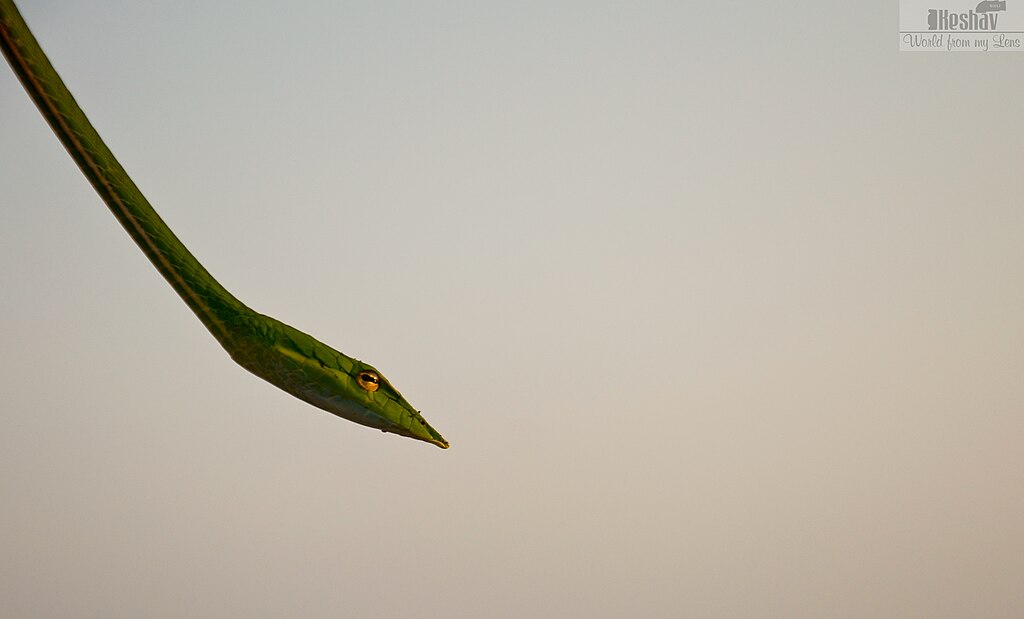
Vine snakes have figured prominently in the folklore and traditional knowledge of many cultures throughout their range. In parts of India, the vine snake is sometimes called the “eye-poking snake” due to a misconception that they target the eyes of humans—in reality, they’re shy and rarely aggressive toward people. Indigenous communities in both Asia and the Americas have long recognized these snakes’ extraordinary camouflage abilities, often incorporating them into stories about forest spirits or trickster figures. Despite their mild venom, vine snakes rarely pose significant medical threats to humans, with bites being uncommon and symptoms typically limited to localized pain and swelling. Traditional healers in some regions have historically used vine snakes in remedies, though these practices have largely disappeared with modernization. Today, eco-tourism operations increasingly highlight these remarkable reptiles as showcase species for visitors interested in witnessing nature’s evolutionary marvels.
The vine snake represents one of nature’s most elegant solutions to the eternal challenges of finding food while avoiding becoming food. Through millions of years of evolutionary refinement, these remarkable reptiles have developed a multifaceted mimicry system that encompasses their physical form, coloration, and perhaps most impressively, their behavior. The swaying movements that so perfectly replicate the gentle motion of flower stems in the breeze epitomize the sophisticated adaptations that can emerge through natural selection. In a world increasingly dominated by human activity, these masters of disguise serve as powerful reminders of nature’s ingenuity and the countless evolutionary wonders that still await discovery in our planet’s remaining wild places. As we continue to study and protect these remarkable creatures, the vine snake’s flower stem mimicry remains an enduring testament to the extraordinary power of evolutionary adaptation.

